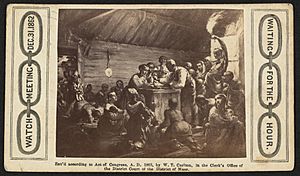Waiting for the Hour facts for kids

Watch Meeting—Dec. 31st 1862—Waiting for the Hour is a famous painting from 1863 by American artist William Tolman Carlton. The original painting's location is currently unknown. However, a different version, possibly an early sketch or study, is displayed in the Lincoln Bedroom at the White House.
This painting shows a special gathering called a "watch meeting." These meetings were originally nighttime religious services, often held by the Methodist Church. The painting captures a secret watch meeting inside a dark wooden cabin. A group of enslaved Black men, women, and children are gathered on December 31, 1862. They are sitting around a makeshift pulpit made from U.S. Sanitary Commission crates.
Contents
The Scene in the Painting
The painting tells a powerful story through its details. An older Black man stands at the pulpit. He holds a book and a large pocket watch. The watch has an anchor at the end of its chain, which is a symbol of hope. To his right, a white woman holds a Black baby. Some people believe these two figures might represent Harriet Beecher Stowe and the character Uncle Tom from her famous book.
Many other women are sitting or kneeling in prayer. One woman is even lying on the floor, showing deep emotion. Everyone in the cabin is waiting with great hope and excitement. They are waiting for the Emancipation Proclamation to be announced by U.S. President Abraham Lincoln. This important document was set to be issued the very next day, January 1, 1863. The people in the painting are anxious to know if the President will truly follow through with his earlier promise from September 22, 1862.
Symbols and Messages
On the left side of the painting, near the doorway, a Black person holds the U.S. flag. It is draped over their arms. Outside the cabin, a bright cross can be seen glowing in the night sky. This adds a spiritual and hopeful feeling to the scene. Inside, a banjo hangs on the wall, suggesting music and culture.
On the right side of the painting, an enslaved person stands holding a torch. They are wearing a neck collar, which was a cruel device used to control enslaved people. The torch lights up a copy of the proclamation pasted to the wall. The words on the paper clearly say: "Proclamation / 1st Jan. / For ever free / Slave". At the very bottom of the painting, the title of the artwork is written on the links of a metal chain. This chain likely symbolizes the chains of slavery being broken.
History of the Painting
The famous abolitionist William Lloyd Garrison admired this painting greatly. An abolitionist was someone who worked to end slavery. In a letter to President Lincoln on January 21, 1865, Garrison called it "an admirable painting." He mentioned that abolitionist supporters in Boston had raised over $500 to buy it as a gift for Lincoln.
After President Lincoln's death, the original painting disappeared. It is thought that his wife, Mary Todd Lincoln, might have removed it. However, a different version of the painting was found in an antiques shop in New York City in 1975. This version might have been a study or a practice painting. In 1976, the Republican Party gave this painting to the White House. This gift celebrated the 200th anniversary of the United States Declaration of Independence, which happened in 1776. Today, this version of the painting is proudly displayed in the Lincoln Bedroom at the White House.
Wider Recognition
The painting became very well-known because many copies were made. These copies were often printed on small cards called cartes de visite. These cards helped spread the image and its powerful message to many people. The details in these printed copies are sometimes even clearer than in the painted version that is now at the White House.
See also
- Art in the White House

